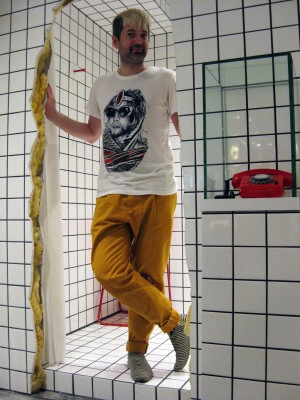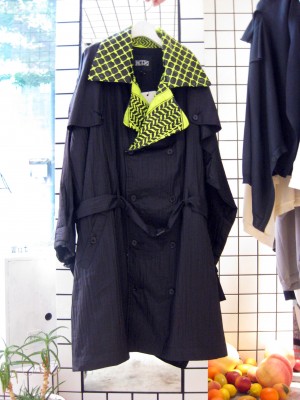Japan Subculture Research Center is going through puberty and heading towards adulthood. After a long discussion with the Japan Subculture Research Center team, we’ve decided to expand the blog to cover not just the underworld and subculture of Japan, but to Japanese pop culture, movies, and books. We’re also reworking the layout to bring you a better, more accessible, easier to navigate format.
Joining the JRSC team is Camille Blanchot, a fashion and set designer originally from France, and now our Special Japan Fashion Correspondent. In her first article, Camille interviewed Yann Le Geoc, the founder and manager of one of Tokyo’s most chic and interesting niche stores, Wut Berlin (東京都渋谷区神宮前5-1-15/5-1-15, Jingumae, Shibuya-ku, Tokyo. Japan). In the interview, Camille is represented by “C” and Yan by “Y.” While this may be readily apparent, we at JSRC feel that you can never over clarify. In other words, we like needless exposition.

C: So, please introduce yourself
Y: I am Yann Le Goec. I am French, 35 years old, and I am a buyer.

C: You have this shop called Wut BERLIN. When did you open your store and how did you found it?
Y: Wut opened in February 2006 in a very little space in Omotesando. Basically the concept was to open a select shop for German designers and the idea came from the president of my company, a Japanese company, HP France.
C: Most Japanese when they think of fashion they think of Italy and France, how did you convince the Japanese fashionistas that German fashion was hip and cool?
Y: That is true, but also sometimes a bit fed up with the same brands so they are always looking for new brands so we have to go to other countries or cities to bring something new to fashion customers.
C: What is it about German fashion that the Japanese like?
Y: There are some German designer which fit the Japanese taste and some who don’t. Especially, German women are very tall, so German designers make clothes for that size of woman.
But some German clothes are in the Japanese taste, not so much into body conscious, not over-sized per se, but not about the sexiness of the clothes, and our best seller is, ANNTIAN, which is a very unisex style of clothes.
Not very masculine, not very feminine.
C: About your shop, please explain the white tile look of the store. And the way the tile cracks in the store. Don’t you worry the Japanese might think the store is failing apart?

Y: The name of the shop is woo which means anger, but means southern anger – as you can see, the front of the store is perfectly done but step by step it is crackling and exploding towards the dressing rooms. I don’t think the customer will think the store is falling apart. I think the customer is seduced by this without understanding the meaning.
C: Has the great tohoku earthquake changed people’s fashion taste?
Y: No, not really. Consumption hasn’t really changed, either. Nothing has been affected except for the first few days after the earthquake, and then everything went back to normal.
C: Who is the most Japanese influenced designer from Berlin?
Y: There aren’t really any German designers who take their influence from Japan. If they do so, I haven’t heard of it.
C: So would you describe your store as Japanese fusion fashion?
Y: I don’t think it’s a fusion, but more German clothes that fit Japanese body.
C: Do you think Japanese people wear German fashion the same way German wears German fashion?
Y: Actually Germans aren’t very fashionable. The brand we sell here they don’t sell at all in Berlin – very few stores, maybe. So German brands are most popular outside of Germany. The brands which are popular in Germany aren’t the brands that would be popular here.
C: How do you market to the Japanese public?
Y: We do a lot of promotions through our website and our blogs – blog is very important to communicate directly with customer. We don’t do a lot of press, as I don’t believe anymore in press power, but we rent a lot of clothes for singers or hair magazines.
C: Do you think magazines are still useful?
Y: It depends on the market, but for stores like ours there almost aren’t any magazines that deal with this kind of fashion. They don’t sell high fashion magazines anymore. But they still sell mass fashion magazines, like kawaii (可愛い)– style magazines, which still surviving.
C: Do you think it is different in Germany?
Y: Yes, press is still very important there.
C: How is your Japanese?
Y: My Japanese is not perfect at all, I don’t think I know the language well. I would say its better to know a little, so you can make sure people know what you are talking about. Actually, there are very few Japanese working in the industry who speak good English.
C: Who is your favorite Japanese designer?
Y: I really like Balmung. He is a very young Japanese designer so not so famous in Japan or Europe.
K: Why do you like Balmung?
Y: Because he makes very particular shapes, which you don’t find in any other Japanese brands, or in Europe fashion. He really has a very particular style, and doesn’t make so many pieces per collection.
C: It’s summer; it’s very hot. What should one wear to survive?
Y: Naked? (laughs) Long, flowing, floor length dress, light, white, even for a man.
C: Sometimes, people think you are German. Why are you selling German clothes?
C: Like I said, it was not my idea in the beginning, it was the president of my company who decided to send me to Berlin- and then I was surprised to find interesting designers. And I think its better to do it like this, because it avoids a nationalistic feeling about it, if I choose it, it’s because I like it, not because it’s my German brother
Yann’s store
C: So, your favorite pieces in your shop?
Y: This coat, a kind of trench coat and I like it because it is made of nylon but on the collars its doubled with leather, and this stitching is a very colorful which is very rare and new and the brand is KTZ.

This brand comes from London.
This is a Japanese brand, this is a bag, it’s the IKEA bag with a leather bottom. I like the idea of making something very cheap expensive. The brand is STOF. And it’s from Tokyo.
This is a Tata Christiane, she makes tunic tops from vintage scarves.

C: Why do you like this item?
Y: I really like her style because she’s a weird designer in Berlin. I like what she is doing.
This is great, I’m pleased to read about stuff like this on this blog, and will have more reasons to check in now. I only wish it weren’t so Tokyo-centric! But it can’t be helped, of course.
Thank you! We’re expanding into pop-culture but we tend to aim for the darker side of the sun.
So interesting you’re moving into fashion!
Occasionally there even are German designers taking some influences from Japan, “Hello Mode” did a line of kimono-style dresses in 2006 (http://www.hello-mode.de/sommerkollektion2006.html). German women are not only taller, but have a different shape than Japanese women. In terms of traditional clothing you’re getting the extreme hourglass shape of the dirndl versus the extreme straight shape of the kimono. Both offer comparable discomfort to the wearer, but that’s the only thing they have in common.
(BTW: the shop’s name is pronounced “woot”, not “woo”.)
I’m casually interested in fashion, no pun intended. (Okay, slightly intended.) Camille remains our resident expert. Thanks for the note on hello-mode.de. I’m thinking of doing the next fashion article on a Japanese kimono designer that makes crazy jikatabi (split-toe) shoes that are really fun. Is “woot” sounded differently than “whoot”?
For me, the height of fashion remains black summer suits made in Japan, that breathe well, and are slim-fit. Everything else is decoration.
Yan said in the article the name would be “woo”, which is a bit different than “Woot”. It doesn’t sound too different than “Whoot” to me, though. Ah, summer suits, fashion is always so much easier for men, simple and comfortable. I envy that. Women’s fashion is a lot more complicated.
I’ll be looking forward to the crazy jikatabi!